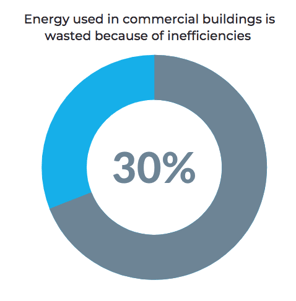Learn how
sensor technology can support hybrid working and why energy consumption needs re-evaluating.
With employees in and out of the office with less regularity due to the pandemic, redefining work and how we function in the workplace is necessary for business continuity.
Key takeaways
-
Hybrid work accommodates emerging needs of the workplace but brings its own set of challenges with regards to energy consumption of office spaces.
-
Environmental and occupancy sensors can guide decision makers in navigating a new mode of work and its corresponding energy demands.
-
Occupancy and environmental sensors can aid in setting and meeting energy consumption targets, fulfilling corporate social responsibility and keeping companies in line with health and environmental regulations.
Hybrid working and its energy impacts
A hybrid work environment, cognizant and supportive of employee needs and tasks, is gaining prominence. As offices closed their doors due to the pandemic, businesses were focused on supporting employees to accomplish their tasks wherever they may be.
Office spaces were left empty and while the return to work is now occurring in staggering paces, a flexible work environment is still necessary for health regulation compliance. Furthermore, it is the
preferred mode of operation for the future by many employees.
In a recent
survey by OpenSensors of more than 1000+ global respondents, to understand how the pandemic has impacted employees and businesses, it was found that 86% of employees want flexible work options.
Needless to say this is driving how organisations are reconfiguring work spaces to adapt to new ways of working.

The hybrid work environment, where employees use the office space as required, brings with it many questions. Businesses will have to work out how to best optimise this mode for employee health and productivity as well as the overarching concern of energy consumption.
An empty or irregularly used office has energy demands, from HVAC systems to other essential devices working in the background ensuring system continuity when necessary.
Calculating these energy requires accuracy, achieved by introducing
environmental and
occupancy sensors which can impact employees' wellbeing, business continuity and the environment.
Assessing the hybrid workspace energy needs
Energy use in buildings dipped as the pandemic hit and employees abandoned office spaces for their homes. Despite this, the energy consumption of empty buildings was nowhere near anticipated levels; this is because zero occupancy doesn’t mean zero energy use.
While there is a need to keep on essential functionalities like HVAC systems to maintain air quality, ill management of buildings are still costing companies and the environment more than necessary; 30% of energy use in buildings are attributed to these inefficiencies.

Source: Environmental Protection Agency (EPA)
Reducing energy consumption
Occupancy sensors, which provide real time data of workspace asset usage are useful in calculating energy demands. As capacity levels fluctuate, businesses can leverage the data the sensors provide and adjust energy consuming systems as necessary.
Controlling fresh air circulation
Regarding HVAC systems, this means using the minimum amount of air ventilation necessary to keep workspaces healthy for the return of employees in the long run.
Environmental sensors, which monitor the air in buildings, can be used to optimise the air quality in the offices to keep employees healthy and energy consumption at a minimum.
Coupled with booking technology, the sensors support hybrid work through synchronising the use of office space between employees and providing analytics for management for designing energy targets and strategies.
Additionally, optimising the use of HVAC and other systems adds to the longevity of the costly systems in place.
Money saved from wasted energy and resources can then be used for other needs of a business.

Benchmark metrics to monitor indoor air quality
Fulfilling CSR and environmental guidelines
The use of sensors is instrumental in ensuring that companies abide by changing regulations on employee health and the environment. This means that as the companies around the world return to work, the way they use their office space will go under heavy scrutiny. Physical distancing protocols will entail a ceiling on the number of employees in a given space and sensors can provide the analytics necessary to keep this number as required.
Employees who have the advantage of
booking systems to reserve desks or meeting rooms in advance, can keep themselves safe and give leaders insight on how office space is being used.

While the health of employees is of paramount importance, energy consumption also dovetails with figuring out how much office space is necessary to carry out operations efficiently. Physical distancing protocols may not necessarily translate to more space in the office, rather a more synchronised and scheduled use of it.
Making strategic data driven decisions
Sensors provide the added benefit of prediction. Strategies crafted based on the analytics they provide will be accurate and flexible in case of future changing health protocols. Using sensor technology enables businesses to design strategies with feasible energy consumption targets allowing for adjustments on the way.
Furthermore, the attention to carbon emissions and by extension energy consumption, has a growing body of laws and regulations to govern it. While there have been guidelines in place like those setting the minimum bars for
energy performance of buildings, paying attention to the buildings office spaces occupy can help businesses stay ahead of the curve and avoid hefty non-compliance penalties along the way.
Want to learn more?
Whether you need help with workplace analytics, consultation on your strategy or guidance on your workplace plans, we're here to help. Call us on +44 (0)20 3868 4376 or
.png)



